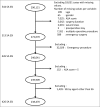Use of surveillance data to identify target populations for Staphylococcus aureus vaccines and prevent surgical site infections: a pilot study
- PMID: 25668663
- PMCID: PMC4514068
- DOI: 10.4161/21645515.2014.979625
Use of surveillance data to identify target populations for Staphylococcus aureus vaccines and prevent surgical site infections: a pilot study
Erratum in
-
Erratum.Hum Vaccin Immunother. 2015;11(10):2511. doi: 10.1080/21645515.2015.1082392. Hum Vaccin Immunother. 2015. PMID: 26376018 Free PMC article. No abstract available.
Abstract
The development of anti-staphylococcal vaccines is nowadays a priority to prevent surgical site infections (SSI). The objective of the present study was to identify a potential target population by assessing surveillance data on surgery patients for possible anti-staphylococcal vaccine administration. Individuals at high risk of SSI by Staphylococcus aureus (SA) were targeted by the French SSI Surveillance Network in south-eastern France between 2008 and 2011. Among 238,470 patients, those undergoing primary total hip replacement appeared to be an interesting and healthy enough population for anti-staphylococcal vaccine testing. These male patients, subjected to multiple procedures and with American Society of Anesthesiologists score>2, had a probability of SA SSI about 21 times higher than females with no severe systemic disease and no multiple procedures. Our study indicates that surveillance data on SSI might be an interesting epidemiological source for planning vaccine trials to prevent nosocomial infections.
Keywords: ASA, American Society of Anesthesiologists; CI, confidence interval; OR, Odds ratio; SA, Staphylococcus aureus; SSI, surgical site infection; Staplylococcus aureus; orthopedic surgery; surgical site infection; surveillance; target population; vaccination.
Figures



Similar articles
-
Use of surveillance data to calculate the sample size and the statistical power of randomized clinical trials testing Staphylococcus aureus vaccine efficacy in orthopedic surgery.Vaccine. 2017 Dec 15;35(50):6934-6937. doi: 10.1016/j.vaccine.2017.10.068. Epub 2017 Oct 28. Vaccine. 2017. PMID: 29089192
-
Impact of vancomycin surgical antibiotic prophylaxis on the development of methicillin-sensitive staphylococcus aureus surgical site infections: report from Australian Surveillance Data (VICNISS).Ann Surg. 2012 Dec;256(6):1089-92. doi: 10.1097/SLA.0b013e31825fa398. Ann Surg. 2012. PMID: 22824854
-
Temporal trends and epidemiology of Staphylococcus aureus surgical site infection in the Swiss surveillance network: a cohort study.J Hosp Infect. 2018 Feb;98(2):118-126. doi: 10.1016/j.jhin.2017.09.025. Epub 2017 Oct 6. J Hosp Infect. 2018. PMID: 28988937
-
Vaccine development to prevent Staphylococcus aureus surgical-site infections.Br J Surg. 2017 Jan;104(2):e41-e54. doi: 10.1002/bjs.10454. Br J Surg. 2017. PMID: 28121039 Review.
-
Staphylococcus aureus antigens and challenges in vaccine development.Expert Rev Vaccines. 2008 Aug;7(6):805-15. doi: 10.1586/14760584.7.6.805. Expert Rev Vaccines. 2008. PMID: 18665778 Review.
References
-
- Song Y, Tai JH, Bartsch SM, Zimmerman RK, Muder RR, Lee BY. The potential economic value of a Staphylococcus aureus vaccine among hemodialysis patients. Vaccine 2012; 30(24):3675-82; PMID:22464963; http://dx.doi.org/10.1016/j.vaccine.2012.03.031 - DOI - PMC - PubMed
-
- Rebeaud F, Bachmann MF. Immunization strategies for clostridium difficile infections. Expert Rev Vaccines 2012; 11(4):469-79; PMID:22551032; http://dx.doi.org/10.1586/erv.12.18 - DOI - PubMed
-
- Voirin N, Barret B, Metzger MH, Vanhems P. Hospital-acquired influenza: a synthesis using the outbreak reports and intervention studies of nosocomial infection (ORION) statement. J Hosp Infect 2009; 71(1):1-14; PMID:18952319; http://dx.doi.org/10.1016/j.jhin.2008.08.013 - DOI - PubMed
-
- Vanhems P, Voirin N, Roche S, Escuret V, Regis C, Gorain C, Pires-Cronenberger S, Giard M, Lina B, Najioullah F, et al. . Risk of influenza-like illness in an acute health care setting during community influenza epidemics in 2004-2005, 2005-2006, and 2006-2007: a prospective study. Arch Intern Med 2011; 171:151-7; PMID:21263105; http://dx.doi.org/10.1001/archinternmed.2010.500 - DOI - PubMed
-
- Bénet T, Régis C, Voirin N, Robert O, Lina B, Cronenberger S, Comte B, Coppéré B, Vanhems P. Influenza vaccination of healthcare workers in acute-care hospitals: a case-control study of its effect on hospital-acquired influenza among patients. BMC Infect Dis 2012; 12:30; http://dx.doi.org/10.1186/1471-2334-12-30 - DOI - PMC - PubMed
Publication types
MeSH terms
Substances
LinkOut - more resources
Full Text Sources
Other Literature Sources
